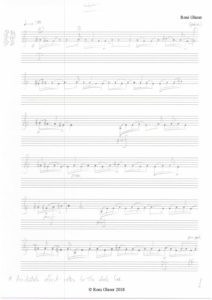
This time I’ll show you how I’m writing some of the second movement of the guitar piece I told you about in the last post, and let you see the first draft:

Contents
The notes
This blog is LIVE, that means you see what I’m writing as I’m writing it. So far I’ve done a first draft of the second movement. You can see it, warts and all, here. It’s not the finalised thing, so you can see bits of annotations about plans, corrections or uncertainties around the notes.
I’m showing it for general interest, and if anyone has any questions or comments (see below), it would be great to hear from you.
I imagine some of you would rather hear it first, but usually nature dictates that learning to play a piece comes after it has been composed, especially if the piece ain’t that easy. You can hear a tiny bit of me messing around with the basic material below, but I’ll do my best to try and play some for you properly next time.
The state of play
As I mentioned, this is a first draft, and it’s as far I’ve got on paper. A few things need to be sorted:
- I need to be more sure that I’m happy with the use of the thematic materials, and there are some that I think could be developed more, either by adding more music, or reworking some bits.
- The notation – the duration of notes could perhaps be more consistent. I might also add some barlines, time signatures and phrase markings to make it easier to see the structure of things. I’d do this when I do a computer version.
- General checking of finer details.
Composing the piece
Starting with the second movement
I’ve started on the second movement, basically because I intended the first and last to be related to the other movements in some way and carry a fair amount of semantic weight, so I began with a different movement to see how things grow from there.
The musical idea of the beginning came to me first, and I felt from its character that it wanted some kind of prelude before it.
Character
As I began to mention last time, here are some of the ideas I have in mind about the character of this movement:
- Rhythmic, with a strong sense of movement
- Quite fast
- An improvised quality
- Smoother and with more flow than the other movements
Guitar technique
I intended to write a very “guitaristic” piece, which for me means one that is natural and comfortable to play on the guitar and minimises the awkwardness that can arise from technical difficulties of a musical idea played on an instrument that it is not necessarily made for.
This essentially means messing around with the instrument and using ways of playing that I like the sound of. Of course, an instrumental technique is not music, but there is no reason why you can’t make a good piece of one.
The basis
I was basically just doing something along the lines of this:
and decided to make a piece out of it.
Techniques
With the left hand, there are ligados (“hammering-on” or “pulling-off” without plucking with the right hand).
With the right hand, there is the use of notes mostly played with the thumb interspersed with open strings, in much the same way as the famous “Asturias” by Albéniz, or Leo Brouwer’s Estudio Sencillo No. 1.
Putting these together, I was able to design an interesting line using just two notes, but varying between ordinary plucking with the thumb, ligado, and an open string. I like how the articulation can be used to vary the accents to rhythmic effect. If you are a guitarist, you’ll know that with a ligado you usually hammer-on or pull-off with the left hand straight after you’ve played a note with the right hand. Here, however, I’ve put other notes played with the right hand between the ligado notes to facilitate the flow of the articulation.
The resonance of the open strings in the melodic line also edges towards the campanella effect, in which notes are played on different strings to allow them to continue to resonate, as bells might. Church bells obviously aren’t as fast as this piece – here I’ve used it for the articulation and the atmosphere it creates.
To be honest, it’s actually a bit confusing, because often the pitch of notes is not in the order of the pitch of the strings. I’m hoping I (and whoever might do me the honour of trying to play this piece) will get over with time, and that it will help to increase mastery of where the notes are on the fretboard.
Next time
Next time I’ll play some of it for you, and talk a little bit about how I’m going about learning to play the piece.
Comments and questions…
… are very welcome, so help yourself to the box below, or send me a message with one of the icons below.
If you’re a guitarist, you could have a go at playing it yourself… do be sure to let me know how you get on!
